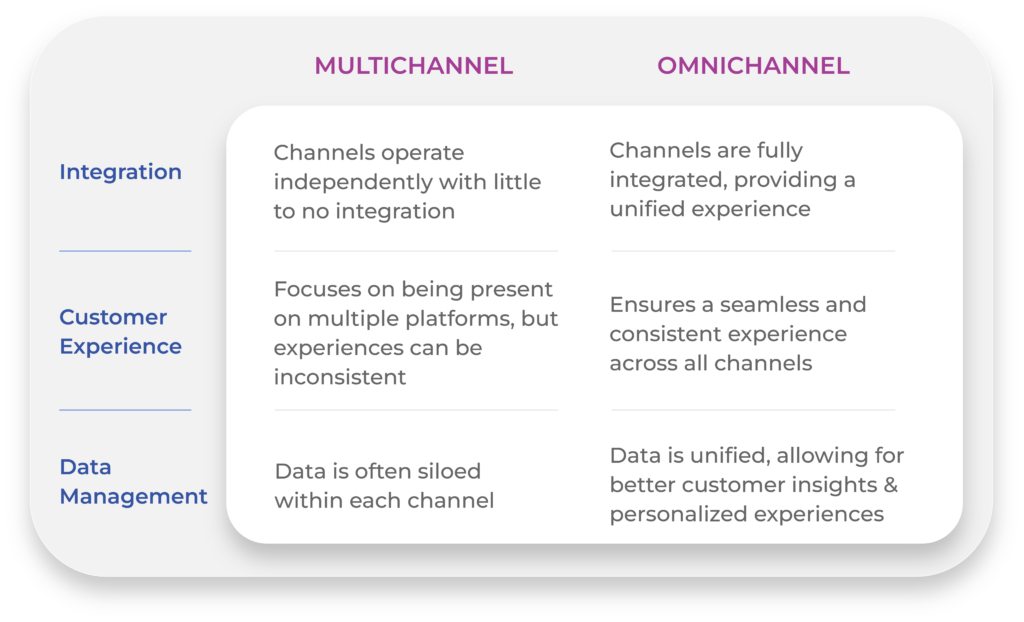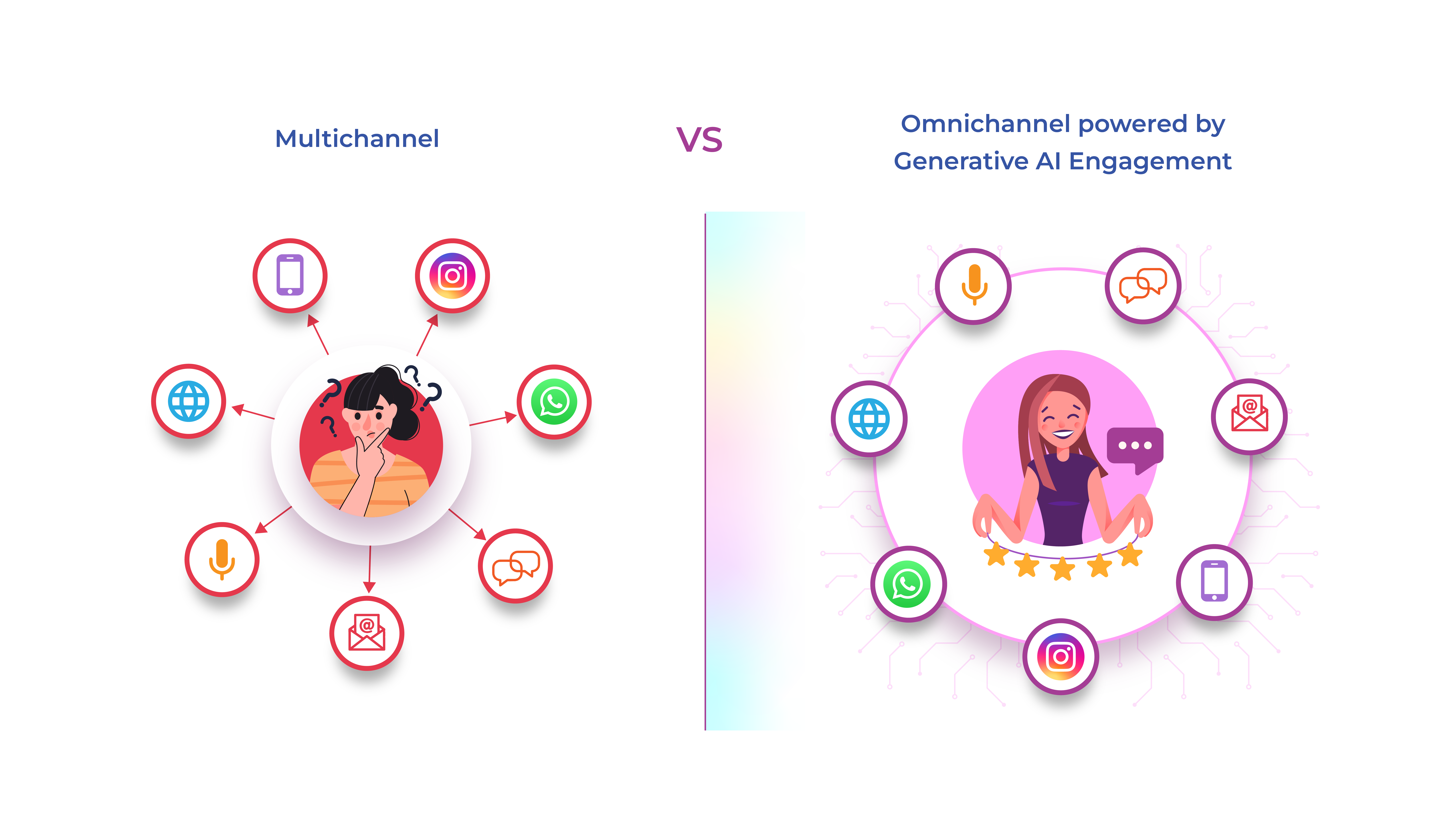Today, most businesses interact with customers through various channels. However, the quality of service across these channels is frequently inconsistent, and data often remains siloed. As a result, customer expectations and business capabilities are often misaligned. This misalignment serves as the foundation for distinguishing and transitioning between these two approaches.
The correlation between higher engagement and omnichannel campaigns can be traced to rising customer expectations, as 90% of customers expect their interactions to be consistent across all channels.
So as mentioned earlier, omnichannel and multichannel strategies may appear alike since both aim to engage customers. However, they are distinctly different.
Let’s begin with the basics.
Understanding Multichannel Engagement
Multichannel engagement involves interacting with customers across various channels, both online and offline. These channels can include:
- Voice: Traditional phone calls and voice assistants.
- Email: Communication via email for support, marketing, and updates.
- Chat: Live chat on websites or messaging apps.
- Print: Physical advertisements, brochures, and direct mail.
- Physical Stores: In-person interactions in brick-and-mortar locations.
The primary focus of a multichannel approach is to establish a presence where customers are likely to interact. Businesses aim to be available across multiple platforms, ensuring that customers can reach them through their preferred channels. However, each channel often operates independently, leading to a lack of integration and consistency in the customer experience.
Exploring Omnichannel Engagement
Omnichannel engagement, on the other hand, takes a more holistic approach. It aims to provide a seamless, integrated experience across all touchpoints and devices. This strategy unifies sales, marketing, and customer service, allowing customers to transition effortlessly between channels without losing context or data.
For instance, a customer can:
- Visit your website from a desktop or mobile device and enjoy a consistent experience.
- Shop at your physical store and find the same promotions and products available online.
- Contact customer service via social media channels like Facebook, Instagram, WhatsApp, Twitter and more and have their issue escalated to a phone call, with all contextual data preserved across channels.
Key Differences Between Multichannel and Omnichannel

Benefits of Omnichannel Engagement
- Enhanced Customer Experience: Omnichannel engagement provides a consistent and personalized experience, making it easier for customers to interact with your brand. This leads to higher customer satisfaction and loyalty.
- Improved Data Insights: With integrated data across all channels, businesses can gain deeper insights into customer behavior and preferences. This enables more effective marketing strategies and personalized communication.
- Increased Customer Retention: By offering a seamless experience, customers are more likely to stay engaged with your brand. This results in higher retention rates and long-term customer relationships.
- Higher Conversion Rates: A consistent and convenient customer journey can significantly boost conversion rates. Customers are more likely to complete purchases when they can transition smoothly between channels.
- Better Resource Allocation: Unified data and integrated systems allow for more efficient resource allocation. Businesses can streamline operations and reduce redundancies, leading to cost savings and improved performance.
Generative AI amplifies the benefits of an omnichannel customer experience (CX) strategy with its exceptional capabilities, which are either absent or very limited in a multichannel approach.
Here’s how Gen AI makes Omnichannel CX approach even better:
- Automated Content Creation:
Gen AI generates personalized and more human like responses across channels which includes chat/voice and email, saving human agents’ time and ensuring consistent communication.
- Accuracy in Intent Identification:
Generative AI’s foundational models for NLP and language understanding accurately interpret intents, enabling the routing of complex queries to human agents while automating simpler requests, thereby optimizing resource use.
- Real-Time Adaptation:
AI adapts interactions in real-time based on the latest customer data, providing a dynamic and responsive experience.
- Scalability:
AI handles a large volume of interactions across multiple channels, ensuring consistent and high-quality engagement.
- Seamless Transition Between Channels:
Generative AI ensures contextual information is carried over when customers move between channels, maintaining a smooth and consistent experience.
- Proactive Customer Support:
AI predicts potential issues and offers proactive support, addressing problems before they escalate and enhancing satisfaction.
The Key Take Away
While both multichannel and omnichannel strategies aim to engage customers across various platforms, the key difference lies in the level of integration and consistency. Multichannel engagement focuses on being present on multiple channels, whereas omnichannel engagement ensures a seamless and unified experience across all touchpoints. Adopting an omnichannel approach offers numerous benefits, including enhanced customer experience, improved data insights, increased retention, higher conversion rates, and better resource allocation.
In a world where customer expectations are continuously evolving, embracing an omnichannel strategy can set your business apart and drive sustainable growth. By delivering a cohesive and personalized experience, you can build stronger relationships with your customers and stay ahead of the competition.
Engagely.ai is revolutionizing customer journeys for businesses and their clients. As the frontline interface for any enterprise, contact centers and call centers play a crucial role. Engagely offers a comprehensive, no-code, omnichannel CX automation platform powered by Generative AI, providing a seamless, integrated solution for enterprises. Get in touch with our AI expert to know more.

Shaikh Sofiyan
Head of Marketing
Sofiyan is a results-driven marketing strategist with deep expertise in marketing management, GTM strategies, brand building, public relations, and integrated communication. With a proven track record across six+ industries, he has partnered with Fortune 500 companies, high-growth startups, founders, and UHNWIs to craft authentic brand narratives that deliver measurable impact. He excels at aligning business goals with bold, insight-led strategies—spanning marketing management, brand management, corporate communications, media relations, sales enablement, and digital storytelling. Known for his ability to bridge strategic thinking with creative execution, Sofiyan focuses on driving growth, enhancing brand reputation, and delivering long-term value. Passionate about turning ideas into outcomes and strategy into success, he brings a clear vision and purposeful approach to every brand he works with.





